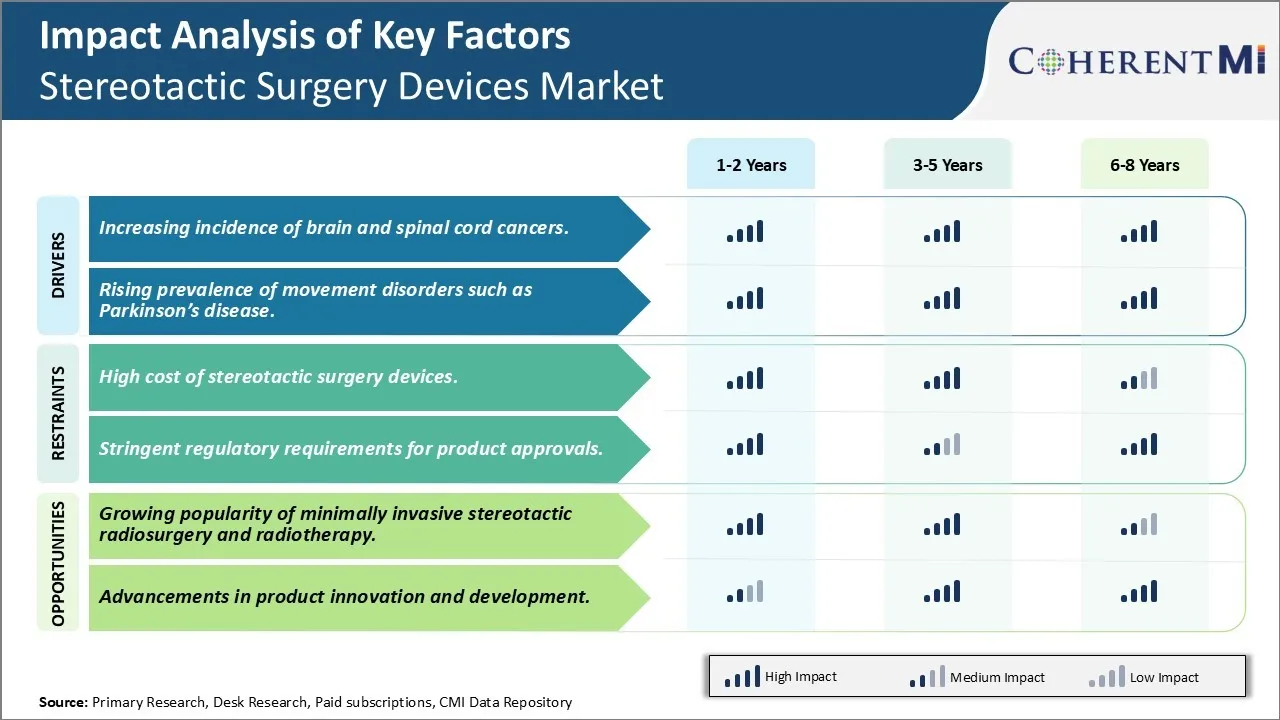Stereotactic Surgery Devices Market Trends
Market Driver - Increasing incidence of brain and spinal cord cancers.
The incidence rates of primary brain and spinal cord cancers have been rising steadily over the past few decades. While these cancers collectively account for only around 1-2% of all new cancer cases diagnosed each year in developed countries, the absolute number of new cases has grown substantially due to the aging and growth of the global population.
Primary brain and spinal cord tumors arise from cells originating from the tissues of the brain and spinal cord. Unlike metastatic cancers, these tumors start and remain confined to the brain or spinal cord. The two most common types of primary brain cancer in adults are glioblastoma and meningioma, which respectively account for around 15% and 36% of all primary brain tumors. For children, the most frequent brain tumors are medulloblastomas, astrocytomas and ependymomas. Risk factors for developing brain and spinal cancers include age, genetic predispositions, exposure to radiation, and certain viral infections.
According to recent statistics, the age-adjusted incidence rates of malignant brain and spinal cord cancers have continuously risen over the past three decades in most parts of the world. In the United States itself, estimates indicate the number of new malignant brain cancer cases increased from around 23,000 in 2017 to over 24,000 in 2021. Projections show these incidence trends will continue going forward as well, largely driven by the increasingly aging global population profile. Additionally, improved diagnostic capabilities using methods like advanced brain imaging scans have led to more brain cancers being detected at earlier stages in recent years compared to the past.
With limited treatment options available for brain cancers, surgery remains one of the core modalities along with chemotherapy and radiation therapy in many cases. Here, minimally invasive neurosurgical procedures enabled by stereotactic technologies offer distinct advantages over conventional open surgeries, including smaller incisions, reduced trauma to normal brain tissues, faster recovery times and fewer complications. These benefits have made stereotactic techniques the standard of care for treating several types of brain tumors and other neurological disorders requiring intracranial access with high precision.
In view of the consistent upward trends witnessed in brain cancer incidence globally and the growing reliance on stereotactic surgical approaches, it can be expected that the rising disease burden will drive greater demand for stereotactic surgery devices and systems in the coming years. Neurosurgical centers are also expected to invest more in advanced stereotactic equipment to address this rising cancer caseload effectively while offering improved outcomes for patients.
Market Driver: Rising Prevalence of Movement Disorders like Parkinson's Disease
Movement disorders refer to a group of conditions characterized by problems with muscle movement. Among the more common forms is Parkinson's disease, a progressive neurodegenerative disorder that results from the loss of dopamine-producing neurons in the brain. Symptoms include tremors, stiffness, slowness of movement, balance problems and other motor complications. Although its causes are still not fully understood, risk factors include increasing age and possible genetic and environmental components.
Statistics indicate the incidence and prevalence of Parkinson's disease has been growing significantly worldwide due to aging populations and improved diagnostics. It is estimated that over 10 million people globally currently suffer from the disease, including over 1 million patients in the United States alone. Prevalence is directly linked to age, increasing the risk after around 60 years, and it is projected that Parkinson’s cases will continue multiplying in the coming decades. Other movement disorders exhibiting similar rising trends include essential tremor and dystonia.
For patients with advanced Parkinson's disease, deep brain stimulation (DBS) therapy delivered by implanting thin electrodes in the brain has emerged as an important treatment approach when medications become ineffective. Stereotactic neurosurgery is required to accurately place the electrode leads in targeted structures like the subthalamic nucleus or internal globus pallidus.

Market Challenge - High Cost of Stereotactic Surgery Devices Limits Further Developments.
One of the major challenges faced by the stereotactic surgery devices market is the high cost of these devices. Stereotactic surgery devices such as gamma knife devices, linear accelerator devices, cyber knife devices, proton beam therapy systems etc. are highly sophisticated machines that employ advanced robotics, imaging, and radiation technology to deliver targeted and minimally invasive treatment. Developing and manufacturing such complex medical devices requires heavy investment in R&D. As a result, the upfront capital cost of these devices is substantial, ranging from several millions to tens of millions of dollars. This high capital expenditure poses a significant barrier for many healthcare providers and facilities to purchase these devices. Moreover, the ongoing costs associated with operation, maintenance, repairs and software upgrades of these advanced devices are also quite high. The high equipment and maintenance costs have restricted widespread adoption of stereotactic surgery technologies especially in cost-sensitive markets. This cost challenge needs to be addressed in order to further propel growth in the stereotactic surgery devices market.
Market Opportunity- Growing Popularity of Minimally Invasive Stereotactic Radiosurgery and Radiotherapy.
One of the major opportunities for the stereotactic surgery devices market is the growing popularity and demand for minimally invasive stereotactic radiosurgery and radiotherapy procedures. Conventional cancer treatments such as whole brain radiation therapy are associated with severe side effects and risks. On the other hand, stereotactic radiosurgery and radiotherapy delivered through devices such as gamma knife, cyberknife allow targeted, high dose radiation to the tumor area while sparing the surrounding healthy tissues. This translates to superior clinical outcomes for patients in terms of local tumor control, fewer side effects, shorter hospital stay and faster recovery. The rising awareness about these benefits among patients as well as physicians has led to increasing preference for minimally invasive stereotactic procedures over traditional surgery or radiation therapy. In addition, aging population demographics, rising cancer incidence worldwide are all contributing to a growing need for effective stereotactic technologies. If device vendors focus on innovations to make these therapies more accessible through lower costs, it can further fuel the demand and adoption of stereotactic surgery globally.